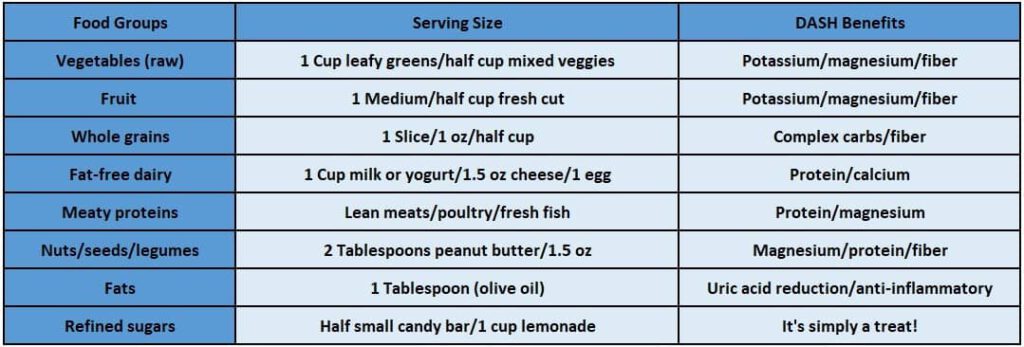The DASH diet has certainly gained lots of notice lately, but it also provides a means to an end for arthritis sufferers.
It also includes many of the excellent ingredients that can possibly reduce inflammation and help manage arthritis better.
Inflammation is the cause of various types of arthritis, and this fad diet decreases the risk of many other chronic conditions, such as hypertension, heart disease, and stroke.
It comes with peace of mind and better living.
Additionally, this arthritis-friendly eating plan includes lots of foods that help to reduce the uric acid that causes painful gout, making it a great natural option to manage this bothersome condition.
What’s the Craze About?
The DASH eating plan doesn’t commit you to specific or expensive foods.
It focuses on daily and weekly nutritional goals instead.
For example, this is what a daily intake might look like if you intend to eat 2,000 calories per day

A weekly calorie limit for the DASH eating plan includes some delectable options too.

The United States Department of Agriculture has a handy online calculator you can use to determine the exact amount of calories you need daily.
It depends on age, gender, level of activity, and body mass index.
The Rules
The eating plan does not include saturated, trans, or hydrogenated fats, which increase inflammation.
Instead, use omega-3 fats and limit your intake.
These can be found in avocados, olive oil, and freshly caught fish.

Fish can be bad for gout, so stick to fish fresh from the ocean.
Processed foods are also not allowed, and neither are refined sugars, full-fat dairy, or too much protein.
Gout sufferers should omit the protein or limit it.
All dairy products must be fat-free, and your sodium intake must be limited to no more than 1,500 mg daily.
This reduces high blood pressure and helps to keep inflammation at bay.
People with rheumatoid arthritis should avoid sodium as much as possible.
They already have elevated levels of sodium that make their battle with arthritis more difficult.
Sodium can activate autoimmune responses.
All your foods should be organic and fresh from the farm because toxins that are present in processed foods, artificial sweeteners, high-fructose corn syrup, and pesticides can create more inflammation, making this an uphill battle.
You’re also encouraged to eat lean proteins and low-carbohydrate foods only.
Low-carbohydrate diets have been proven to relieve the pain of osteoarthritis.

Researchers at Harvard Medical School have confirmed that too many carbs can correlate with an increased risk of rheumatoid arthritis.
Stick to complex carbs found in leafy green vegetables, such as cabbage, organic kale, and bok choy.
You’ll also be eating foods rich in potassium, fiber, and magnesium, which improve arthritis management.
Fiber absorbs uric acid in the bloodstream, and potassium is replaced in rheumatoid arthritis sufferers, which improves pain management.
Food Groups and Serving Sizes
It certainly helps to know what food groups you can enjoy and what’s considered a single serving of each.
The first chart shows the average serving sizes for various food groups.

The second chart shows what foods are included in each group.

You’ll also notice popcorn on the list, which makes another treat that doesn’t take away from your sweet allowance.
Just remember not to cover it with salt which is a no-no.
You can also replace your fat-free milk with almond milk if you’re lactose intolerant.
Here are some ways you can reduce your sodium intake, especially if you’re a lover of salty foods:
- Stay away from processed foods.
- Buy fresh products from the farmer’s market and eat them raw.
- Cook your own food and stop eating out.
- Add natural spices and herbs to your food.
Some natural spices and herbs can also reduce inflammation.
Tips to Stick to the Plan
The idea of dieting alone can already offset your mood, but this isn’t a short-term change.
It’s a lifelong journey to keep your arthritis under proper management.
Ask yourself whether you want to stop the stiffness and pain that you live with or not.
If you do, use these tips to stay on track:
- Ask yourself what made you choose the DASH eating plan. Was it your condition, and how bad did it become to make this change?
- Now, ask yourself why you feel the urge to drop the plan. Was there stress in your workplace, or did you have cravings? Knowing what made you stray can get you back on track.
- Don’t beat yourself over the head for steering back to old habits. This never achieved anything. Instead, get back on the horse.
- Keep plans written down to make it harder to stray.
- Celebrate little successes when you notice how your pain has diminished. Treat yourself to a new pair of yoga pants or a new book.
Final Thoughts
There’s nothing you can’t do if you put your heart to it.
Don’t let minor calculations and calorie counting get you down.
The pros will outweigh the cons when you can play catch with your grandchild or take your kids to the next basketball game.
Without pain, you can jump and cheer for your favorite team.
Enjoy that wonderful experience with loved ones.
When your pain is better, you enjoy life more.

Doctor Loy
Loy Puckett MD
Emergency Medicine – 28 Years Experience


